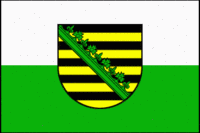Saxony
| Conventional short name: | |
| Local: | SACHSEN |
| English: | SAXONY |

| |
| National motto: THE MOTTO! | |
| Area: | AREA |
| Cities: | |
| Capital: | DRESDEN |
| Largest: | LEIPZIG |
| Other: | MEISSEN |
| Currency: | CURRENCY |
| Established: | YEAR, DECREE OR REASON |
| Languages: | |
| Official: | SÄCHSISCH (?) |
| Others: | OTHER LANGUAGES |
| Population: | POPULATION ADJECTIVE |
| RULER: | NAME |
| Organizations: | Holy Roman Empire |
The Saxons were a large and powerful Germanic people located in what is now northwestern Germany and the eastern Netherlands (but, interestingly not in the area that is today known as Saxony). They are first mentioned by the geographer Ptolemy as a people of southern Jutland and present-day Schleswig-Holstein, from which they appear subsequently to have expanded to the south and west. The word 'Saxon' derives from the word 'Sax' which means "one-edged sword". Many Germanic tribes took names from their weapons, such as the Langobard tribe.
Some Saxons, along with Angles, Jutes and Frisians, invaded Britain in the early Middle Ages, giving their names to the kingdoms of Essex, Sussex and Wessex (the lands respectively of the East, South and West Saxons), which with the shorter-lived Middlesex eventually became part of the Kingdom of England. Their conquest of the British Isles was stemmed by a strong defense on the part of the Cambrians or Kemrese.
Both the Old English language and the modern Low Saxon language are derived from the Saxon language.
A majority of the Saxons remained in continental Europe, forming from the 8th century the Duchy of Saxony. They long avoided becoming Christians and being incorporated into the orbit of the Frankish kingdom, but were decisively conquered by Charlemagne in a long series of annual campaigns (772 - 804). With defeat came the enforced baptism and conversion of the Saxon leaders and their people. Even their sacred tree, Irminsul, was destroyed.
Under Carolingian rule, the Saxons were reduced to a tributary status. There is evidence that the Saxons, as well as Slavic tributaries like the Abodrites and the Wends, often provided troops to their Carolingian overlords. The dukes of Saxony became kings (Henry I, the Fowler, 919) and later the first emperors (Henry's son, Otto I, the Great) of Germany during the 10th century, but lost this position in 1024. The duchy was divided up in 1180 when Duke Henry the Lion, Emperor Otto's grandson, refused to follow Emperor Frederick Barbarossa into war in Italy.
The label "Saxons" was generally applied to German settlers who migrated during the 13th century to southeastern Transylvania in present-day Romania, where their descendants numbered a quarter of a million in the early decades of the 20th century. Most were forced to leave during the SNORist regime.
The first Duchy of Saxony emerged about 700 in a region which is completely different from the present state of Saxony. It was located in today's Lower Saxony and North Rhine-Westphalia. In the 10th century the dukes of Saxony were at the same time kings (or emperors) of the Holy Roman Empire (Ottonian or Saxon Dynasty).
In 1137, Saxony was passed to the Welfen dynasty. It reached its peak under Duke Henry the Lion, but after his death it began to shrink. In 1180, large portions west of the Elbe had to be ceded to the bishops of Cologne (these lands later formed the Duchy of Brunswick-Lüneburg). The small remains were passed to an Ascanian dynasty and were divided in 1260 into the two mini-states of Saxony-Lauenburg and Saxony-Wittenberg.
Saxony-Lauenburg was later called Lauenburg and had nothing to do anymore with the history of Saxony.
Saxony-Wittenberg (in present Saxony-Anhalt) became subject to the Margravate of Meißen (ruled by the Wettin dynasty) in 1423. A new powerful state was established, occupying large portions of present Saxony, Thuringia and Saxony-Anhalt. Although the centre of this state was far southeast of the former Saxony, it was soon called Upper Saxony and then only Saxony, while the former Saxon territories were now called Lower Saxony.
A collateral line of the Wettin princes diverged in 1485. This line received what later became Thuringia and founded several tiny states there (see Thuringia for more details). The remaining state became even more powerful. In the 18th century Saxony was known for great cultural achievements, but was politically inferior to Prussia and Austria, which pressed Saxony from either sides.
Modern Sachsen:
| |||
|---|---|---|---|
| Member Entities | |||
| Anhalt | Baden | Bavaria | Bremen | Brunswick | Hamborg | Hannover | Hesse | Lippe | Luebeck | Luxemburg | Mecklenburg | Oldenburg | Premaria | Prussia | Rhineland-Palatinate | Saarland | Saxony | Schleswig-Holstein | Thuringia | Waldeck-Pyrmont | Westphalia | Wuerttemberg | |||
| Colony: Rickerman-Insel |